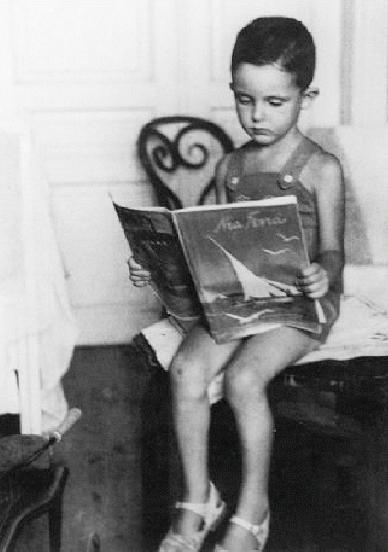
Greek Boys Garments: Footwear

Figure 1.-- This charming portrait shows a boy reading a vopy of "Nea Genia" (New Generation), a magazine published from 1946-1961. The photograph was probably taken in the 1950s. He wears a kind of bib-overall sunsuit and sandals. Outfits like this were common play suits for boys up to about 7-8 years of age.
|
|
Greece was a poor country in the 19th century and many children went barefoot. Climate was another factor. In contrast to northern Europe, the climate made it much more practical for more children to go barefoot and for much of the year. This was very common until after World War II and the Greek Civil War which prolonged the War in Greece. Children with shoes in the 19th century might wear oftern wore heavy book-like shoes although boys frpm affluent damilies might wear more fashional footwear. we do not yet have a handle on this as our 19th century archive is so limited. In the 20th century children still commonly often went barefoot through the 1940s, the aftermath of World War II and the Civil War causing emense economic dislocations. As the economy has improved, children less commonly go barefoot. Sandals since World War I have proven very popular and Greek children often wore thenm without socks. We also see boys and girls wearing strap shoes. A good example is an unidentfied boy in 1930s family portrait. As the century progressed we see more and more children wearing shoes or sandals. This was the case for the upper and middle-class. We see a sigbificant rural/urban divide concerning footwear. A economic conditions improved we see working-class and rural children also wearing footwear. Since the 1980s sneakers have become increasing popular. By the 1950s most children were wearing footwear/ Shoes were increasingly common.
Chronology
Greece was a poor country in the 19th century and many children went barefoot. Our 19th century archive is very limited. Thus we do not yet have a handle on 19th century footwear. We see children wearing varied footwear in the 19th centyry, including high-top shoes. We know much more about the 20th century.
Climate
Climate was another factor. In contrast to northern Europe, the climate made it much more practical for more children to go barefoot and for much of the year. This was very common until after World War II and the Greek Civil War which prolonged the War in Greece.
Children with shoes in the 19th century might wear oftern wore heavy boot-like shoes although boys frpm affluent damilies might wear more fashional footwear. There were also low-cut shoes. but our information is limited. In the 20th century children in rural areas still commonly often went barefoot through the 1940s. We both high-top and low-cut shoes. We also see boys and girls wearing strap shoes. They seem very commonly with children from well-to-do and middle-clas families. A good example is an unidentfied boy in 1930s family portrait. World War II and the Civil War caused emense economic dislocations. High-top shoes declined significantly during the 1930s. As the economy has improved, children less commonly went barefoot. Sandals since World War I have proven very popular and Greek children often wore them without socks. As the century progressed we see more and more children wearing shoes or sandals. We do not see sneakers until after World War II.
Since the 1980s sneakers have become increasing popular. By the 1950s most children were wearing footwear. Shoes were increasingly common.
Social Class
Upper and middle-class children wore footwear even in the 19th century. We see a significant rural/urban divide concerning footwear. Foowear was much less common for working-claa childre, especially rural children. Footwwear especially lether footwear is the most most expensive clothing items. A economic conditions improved we see working-class and rural children also wearing footwear.
HBC

Navigate the Boys' Historical Clothing Web Site:
[About Us]
[Introduction]
[Activities]
[Biographies]
[Chronology]
[Clothing styles]
[Countries]
[Bibliographies]
[Contributions]
[FAQs]
[Glossaries]
[Images]
[Links]
[Registration]
[Tools]
[Boys' Clothing Home]
Navigate the Boys' Historical Clothing Belgin pages:
[Return to the Main Greek Western garment page]
[Return to the Main Greek garment page]
[Greek choirs]
[Greek folk costumes]
[Greek movies]
[Greek royals]
[Greek schools]
[Greek youth groups]
Last updated: 11:38 AM 1/30/2017



